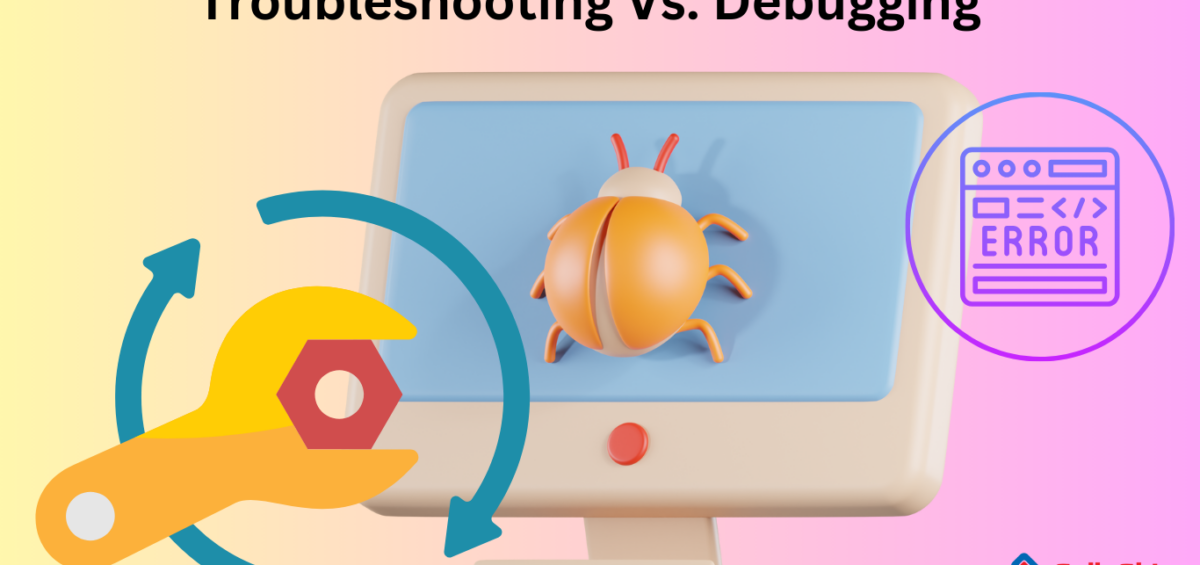In the world of software development and IT, identifying and resolving issues or errors is an everyday challenge.
Two essential processes – Troubleshooting and Debugging, serve as the twin pillars of problem-solving in this domain. While they may seem similar, understanding the distinctions between them is crucial for effective issue resolution. In this blog, we’ll delve into the depths of troubleshooting and debugging, exploring their objectives, scope, approaches, and resolutions.
Troubleshooting: The Holistic Problem-Solving Approach
Objective: Troubleshooting is akin to a detective’s work. It aims to tackle a wide range of issues plaguing a system or process. These issues could encompass software bugs, configuration errors, performance bottlenecks, hardware malfunctions, network glitches, or even problems arising from user interactions.
Scope: Troubleshooting has a broad scope. It’s not limited to software alone but extends to hardware, networks, and even environmental factors affecting overall system performance.
Approach: The troubleshooting process starts with identifying symptoms or issues reported by users or observed by administrators. It involves collecting information from various sources, including diagnostic tools, logs, and user feedback. Troubleshooting requires a diverse skill set, combining technical knowledge and problem-solving abilities to pinpoint the root cause.
Resolution: Resolving troubleshooting issues can take various forms, such as adjusting configurations, rebooting systems, applying software updates or patches, or even seeking expert assistance when necessary.
Debugging: The Code-Centric Precision
Objective: Debugging is a specialized process, focusing exclusively on eliminating software bugs or errors in a program’s source code. The primary goal is to restore the correct functioning of the software by identifying and rectifying code-related issues.
Scope: Debugging confines itself to the realm of software and code. It involves a meticulous examination of the codebase, variables, and program execution to locate the source of the problem.
Approach: Debugging begins with isolating the troublesome code or specific portions of the software where issues manifest. Developers employ debugging tools and techniques like setting breakpoints, inspecting variables, and tracing program execution to gain insights into what’s going wrong.
Resolution: The resolution in debugging is all about making changes to the source code. This may involve correcting logic errors, addressing syntax issues, improving error handling, or refactoring the code to enhance performance.
Conclusion: The Synergy of Troubleshooting and Debugging
In the dynamic world of IT and software development, both troubleshooting and debugging play indispensable roles in ensuring system reliability and functionality.
Troubleshooting’s wide-reaching approach makes it the go-to method for identifying and addressing a diverse array of issues. It’s the first line of defense when it comes to maintaining a system’s health and tackling multifaceted challenges.
Debugging, on the other hand, is the precision tool for developers seeking to perfect their code. It allows them to dive deep into the intricacies of software and surgically remove bugs that impede performance and functionality.
In essence, troubleshooting and debugging complement each other. Troubleshooting casts a wide net to identify issues, while debugging surgically repairs code-level problems. The synergy between these processes is vital for keeping systems and software running smoothly.
So, whether you’re a seasoned IT professional or a budding developer, understanding the nuances of troubleshooting and debugging is essential for effectively solving problems and ensuring the seamless operation of systems and applications. These two tools in your problem-solving arsenal will help you navigate the complex landscape of IT and software development with confidence and finesse.







Leave a Comment